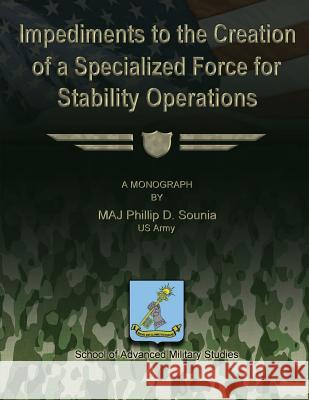Impediments to the Creation of a Specialized Force for Stability Operations » książka
Impediments to the Creation of a Specialized Force for Stability Operations
ISBN-13: 9781480029958 / Angielski / Miękka / 2012 / 44 str.
Impediments to the Creation of a Specialized Force for Stability Operations
ISBN-13: 9781480029958 / Angielski / Miękka / 2012 / 44 str.
(netto: 60,61 VAT: 5%)
Najniższa cena z 30 dni: 64,00
ok. 16-18 dni roboczych
Bez gwarancji dostawy przed świętami
Darmowa dostawa!
This study is an assessment of the Department of Defense's response to the call to create specialized forces to address the exigent strategic requirement for stability and reconstruction operations in Afghanistan and Iraq. To make an assessment it was necessary first to understand the reason for the call by analyzing the different proposals and the analogy made with the Vietnam-era CORDS program. That analysis revealed that the passage of time has sanitized the memory of CORDS from the political considerations that facilitated its creation. Today, there are significantly more political issues to address before implementing a force development program. The analysis exposed DOD's response to the call for new organizations. The DOD response did not directly prevent creating specialized units for stability operations, but it did delay the serious consideration of those proposals. How DOD embraced the need for stability and reconstruction operations while fending off the creation of specialized units is a story that reveals in bold relief the salient features of congressional defense and budgetary politics. The study found that advocates for a specialized force fail to realize that strategic requirements are only one of the important factors that the Department of Defense must weigh before undertaking resource intensive initiatives. As an agency of the US government, the Department of Defense must navigate a course that addresses the political environment as well as operational requirements. In today's political environment, the DOD must consider the partisan political relationship between the executive and legislative branches along with the impact that a new initiative will have upon the implementation of ongoing programs. The Department must also identify the consequences associated with creating additional resource demands and the effect of the new demands on the budget distribution between existing programs, agencies, and current operations. By considering these inter-related factors along with the strategic requirements, it is possible to understand better the Department of Defense's reluctance to create specialized units for stability and reconstruction operations. This study found that the Department of Defense staved off efforts to create a specialized force for stability operations because DOD and specifically the Army had already committed to transforming to a modular brigade construct. The Army committed to modularity in an effort to solve the problem of efficiently rotating dissimilar units through an enduring conflict. Once committed to Army modularity, the Army did not have the resources to support a second transformation towards stability operations, regardless of strategic requirements. In an effort to stave off stability force advocates, DOD took steps to delay addressing the strategic requirement of stability operations with any initiative that would compete with modularity for resources. By ignoring, retarding, and manipulating initiatives to create a specialized force for stability operations the Army and DOD protected the institutional objective, of modular transformation.
Zawartość książki może nie spełniać oczekiwań – reklamacje nie obejmują treści, która mogła nie być redakcyjnie ani merytorycznie opracowana.











